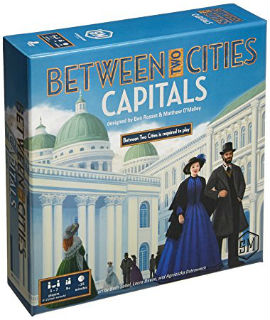



play board games
Board game reviews, strategy tips & session reports
Between Two Cities Capitals Expansion Review
 Stats:
Stats:
No. of players: 1-7
Amount of time to play: 30-40 min
Age requirements: 10+
Set-up time: 5 min
Capitals adds more ways to score and depth to Between Two Cities without adding too many new rules.
Between Two Cities Capitals Expansion Rules Description:
Between Two Cities is a fun tile-laying game for one to seven players. And Capitals is its first expansion. I am going to assume you know the basics of how to play the base game. But you know what they say about assuming… If you have not tried the base game, read my overview and review of it here. They rest of this post will focus on new things the Capitals expansion adds to the game. Mainly, landscapes, districts and civic tiles.
Now at the start of each game each city is dealt a landscape mat. This changes a few things in the game. Now your city will be a 5 by 5 grid and you won’t always be able to place tiles anywhere you want. Given the larger city you now draw nine tiles in stages 1 and 3 and the tile you place must be on the landscape map.
Districts are made up of two types of tiles. At the end of the game you score VP based on having these two types orthogonally adjacent in your city. There are three districts that score first and second place for the largest district. If you get a district of factories and houses one of them is discarded and replaced with another tile type.
Civic tiles are a new type of tile and are purple. They have two tile types they want to be next to and one they don’t. If they are adjacent to the type they are not fond of, they score one VP period that is all. However if they score three VPs if they are next to one of the tile types they like and six VPs if they are adjacent to both types. It doesn’t matter how many of each type it is a flat 3 VPs for each type.
Quick Review of the Capitals Expansion:
The Capitals expansion adds an additional layer of things to be aware of (and strategize about) in Between Two Cities. Capitals makes Between Two Cities a meatier game. But it does so without adding a lot of rules. This makes it a stepping stone from the base game for newer gamers.
The components for this game are great just like those in the base game. The tiles, art and rules are all well done.
The new elements do not add a bunch of new rules but do add more ways to score. And like I said there is more to keep track of. So there is added complexity but not because you need to learn a bunch of new rules. The elements are added elegantly and make sense thematically too.
Some of my favorite things about the base game are how well it scales, the number of players and how easy it is to teach. And this expansion keeps the number of players and scaling intact. Your game experience is very similar with any player count from three to seven. And though there is more to teach nothing is that complex for most to grasp.
If you enjoy Between Two Cities but want to add a bit more depth and variety to the game play, pick up the Capital expansion. The base game and this expansion combine to make a nice gateway game to which you can add some complexity with the expansion easily.
Score and synopsis: (Click here for an explanation of these review categories.)
Strategy 4 out of 6
Luck 4 out of 6
Player Interaction 3 out of 6
Replay Value 4 out of 6
Complexity 2 out of 6
Fun 4 out of 6
Overall 4 out of 6

Leave a Reply